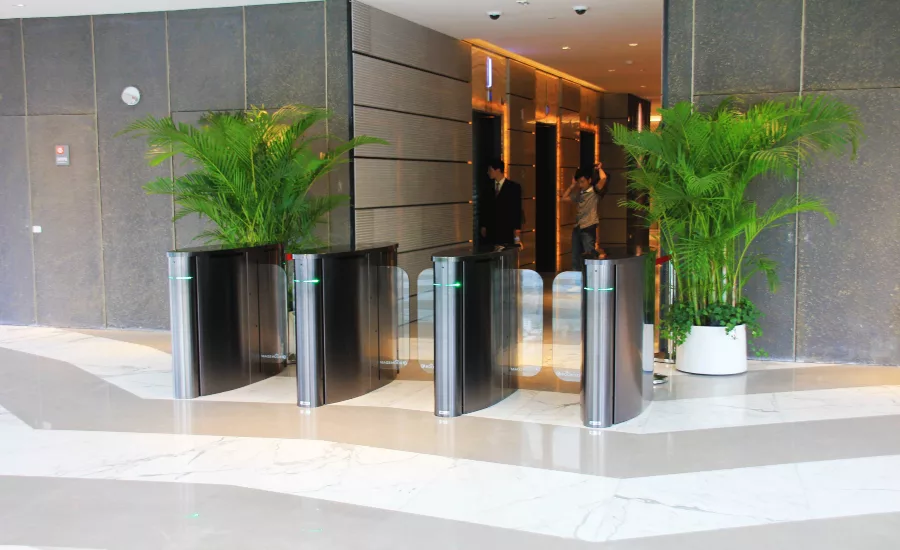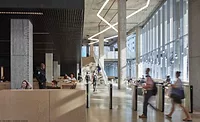Four Reasons Why Your Active Shooter Plan Should Include Security Entrances

Photo courtesy of Boon Edam
The Mass Shooting Tracker is a crowd-sourced database of U.S. mass shootings, which are defined as a single outburst of violence in which more than three people are shot. Using this parameter, the Tracker reported that in 2019 there were 374 mass shootings in the United States – more than one for each day of the year.
Given this reality, it is essential to take all possible steps to protect your employees and visitors from harm. It is also important to consider the liability – both business and personal – that executive management may face should there be an incident on the premises. For this reason, it should be a core requirement of every organization’s security plan to give serious consideration to how they will thwart an active shooter.
Putting a security plan in place to guard against on-site violence begins at the perimeter, and security entrances are a strong first line of defense against the threat of an active shooter. Here are four reasons why your active shooter plan should include security entrances.
-
They form a physical barrier that is a strong, visual deterrent to crime and violence.
Security entrances have one thing in common – they form a barrier or obstruction to free entry and are the largest visible sign that a physical security plan and policy exists at a facility. Compare the sight of a building with security turnstiles in the lobby and security revolving doors at the side entrances for employees, versus a building that does not have these entrances…what looks easier and more vulnerable?
Security entrances are a strong visual deterrent against casual attempts at crime or violence because the perpetrator will likely move on to another easier target. And, if this person is very determined to bypass security entrances they will have a lot more planning to do to attempt to enter undetected and cause harm, which brings us to the next point.
-
They guard against piggybacking and tailgating.
The key to preventing an active shooter is to prevent him or her from getting inside a facility to wreak havoc. With a swinging door, it is much easier for a shooter to get inside even if you use an access control system and credential readers at your doors. They can either follow an authorized user inside without their consent (tailgate) or coerce a user to bring them in (piggyback). Security entrances can make either scenario much more difficult to near impossible, especially when deployed in layers around a facility.
At outer layers, for example, a full height turnstile installed on a fence line rotates so that only one person can enter on a valid credential and then it locks again. Inside a lobby, optical turnstiles with swinging or sliding barriers and sensors inside their lanes can detect tailgating and alarm if it happens. These should be supervised at all times in case of an alarm and breach, but as stated earlier the active shooter must plan a great deal to get past them and gain access to more targets in a short amount of time before the police can arrive.
Then what about piggybacking through coercion? There are security entrances that stop that with anti-piggybacking technology. This technology detects the presence of a second person within the entrance and rejects the entry for both, effectively making it impossible for an uncredentialed individual to enter. How does this work?
Usually the detection hardware is placed in the ceiling of a security revolving door or mantrap portal. Using a combination of an optical camera and active, near-infrared sensors, the advanced analytics technology can recognize shapes, sizes and volume in three dimensions. The system scans the compartment within the security entrance to identify a head and shoulders, along with a body shape and will reject any unusual shapes, requiring those within the compartment to exit back to the non-secure side of the door. Because this technology is so reliable, no manned supervision is needed at these entries. The active shooter is forced to find another entry as well. If they decide to try to shoot their way in, there’s something for that as well.
-
They can protect the people inside the building from gunfire.
To further ensure that people within the facility are protected from weapons being discharged outside, security revolving doors and mantrap portals are available with bullet-resistant (BR) glass. This special glass is made from layers of a tough plastic called polycarbonate, sandwiched between sheets of toughened glass.
There are a number of different BR-rated protection levels; security revolving doors and mantrap portals can be outfitted in BR glass with protection Level 3, which is 1.04” thick, more than four times the thickness of standard security door glass. Level 3 BR glass is capable of stopping three .44 magnum bullets or a bullet that is twice as heavy and moves significantly faster than the bullet of a 9mm handgun. In the end, the shielding ability of BR glass may deter a shooter from spending time focused on shooting a door, or, it can buy enough time for someone inside the door to get inside to safety.
-
They can prevent a weapon-carrying individual from entering.
We’ve described earlier in this article how security entrances can deter, detect and prevent tailgating and piggybacking. You can enhance your security further by pairing this capability with an electromagnetic metal detector to ensure that no weapons can be brought into your facility by anyone. Metal detectors for pedestrians are often shaped like a doorway, and they can be placed in front of a security entrance to scan the user before they enter the entrance. If metal is detected, the security entrance will stay locked. This combination is very effective at stopping even an authorized user from bringing danger inside a building.
The Best Preparations for the Worst-Case Scenario
Any active shooter preparedness needs to encompass a number of elements. Employees, students or other individuals who are in the facility on a daily basis should receive active shooter training in the form of drills conducted by a qualified provider. Interior spaces should be configured for readiness with the ability to lock down all doors instantly from a central location. Communications capabilities should be available within the facility to help contain the threat and protect people on site, and directly to first responders to help them know where to target their actions.
At the perimeter, active shooter preparedness should include the selection and installation of entry solutions that help protect the lives inside. Security entrances can fill that need in a variety of ways and should be a primary consideration for organizations today.
Looking for a reprint of this article?
From high-res PDFs to custom plaques, order your copy today!









